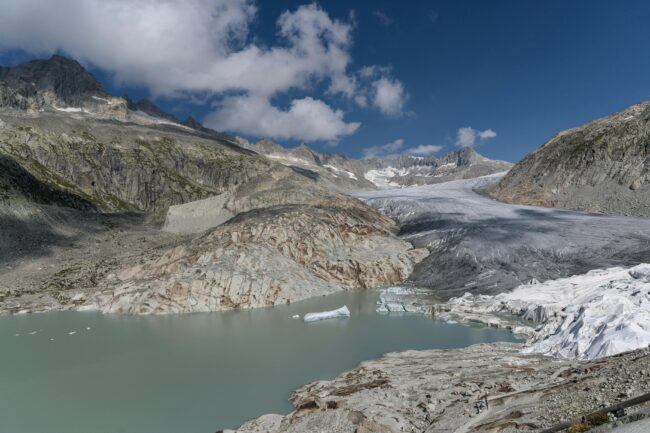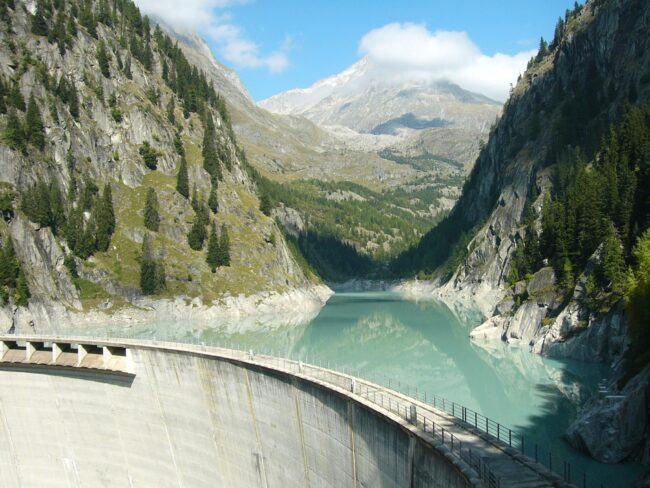
A report from the Swiss Federal Council states that terrain newly exposed by glacier melt may allow for expanded hydropower infrastructure. Facilities in these areas could generate up to 3,900 gigawatt-hours (GWh) of energy annually by 2050, enough to power hundreds of thousands of homes. The Swiss Ministry of Energy has already selected a set of hydropower projects to prioritize, several of which are on the newly exposed land, setting in motion the process to exploit this potential.
Implementing these projects, however, comes with a range of environmental, legal and regulatory challenges, which Switzerland has begun to tackle through collaborative efforts and planning.
Switzerland is a federal republic made up of 26 cantons, or member states, each with significant autonomy. The Federal Council, the country’s executive branch, released the 2025 report in response to a 2021 motion reflecting growing legislative interest in the potential for hydropower infrastructure near glaciers. The Parliament—made up of the Council of States and the National Council, similar to the United States’ Senate and House of Representatives—initiated and passed a law that eases planning for new hydropower projects.
Glacier Retreat and Hydropower
Lands near glaciers, which are exposed to cycles of thawing and freezing as glaciers advance and retreat, are called periglacial areas. In the last 40 years, Switzerland has lost over 300 square kilometers of glacier area, significantly expanding the periglacial landscape. Some of these areas could be used for new or expanded reservoirs and for hydropower plants.
Historically, glaciers have been a vital source of freshwater in Switzerland. They feed reservoirs that power the country’s extensive hydropower network, which supplies almost 60 percent of its domestic electricity. Hydropower is also important to Switzerland’s Energy Strategy 2050, which includes goals to increase hydropower generation to 39.2 terawatt-hours (TWh) annually by 2050, requiring an increase of at least 4.3 TWh per year.

The report, titled “Analysis of the Hydropower Potential of Glacier Melt,” was released in the context of these energy goals. It shows that while melting glaciers could threaten hydropower by reducing water flow to reservoirs, glacier retreat also creates an opportunity for increased hydropower production. The report estimates that areas both recently revealed by glacial melt and currently beneath ice could yield 1,470 GWh of additional annual energy production and 2,430 GWh of seasonal energy storage every year, which is particularly important for ensuring winter energy security.
Challenges to Hydropower Expansion in Periglacial Areas
Much of this potential for new hydropower facilities in periglacial areas lies in environmentally sensitive floodplains and landscapes, many of which are safeguarded under Swiss environmental laws. The status of these landscapes raises questions about how Switzerland can plan for hydropower projects in periglacial areas without compromising other environmental regulations.
Only about one percent of the hydropower projects are entirely outside protected floodplains. A significant portion of the projects, about 540 gigawatt hours (GWh) of potential energy, would require infrastructure in floodplains of national importance, which are legally untouchable due to their status in the Floodplain Ordinance inventory. Another 910 GWh of potential lies in floodplains not classified as nationally important but still subject to varying degrees of protection. “Almost all projects will face some conflict between floodplain protection and energy use,” the report warns.
Other complications stem from designations of environmental and cultural significance. One-third of the potential lies within UNESCO World Heritage Sites, where international oversight adds another obstacle. The International Hydropower Association, whose members include many of Switzerland’s largest hydropower companies, has pledged not to develop any projects within UNESCO sites. Beyond World Heritage Sites and protected floodplains, another 1,150 GWh per year falls within federally protected areas, such as the Inventory of Landscapes of National Importance, making approvals legally and politically complex.
Additionally, environmental NGOs often challenge projects in ecologically sensitive areas. As Swiss Federal Institute of Technology Zurich professor and hydropower expert Michael Ambühl told GlacierHub in an interview, “important NGOs are often not in favor of hydropower dams in periglacial areas.” Ambühl remarked that it may be the national NGOs that object because “local ones are sometimes … well integrated in the local society, which is in many cases not against new infrastructure projects, as they contribute to the development of the local economy.”
The report also highlights that proposed hydropower projects face long approval processes, which can stretch over two decades. Renegotiations for expiring concessions can also lead to delays in implementing new projects. Profitability poses another challenge, particularly for projects focused on increasing energy storage capacity, though Switzerland’s Energy Strategy 2050 includes financial measures to mitigate these risks.
Klaus Jacob, a geophysicist at Lamont-Doherty Earth Observatory, which is part of the Columbia Climate School, expanded on the issue of profitability in an interview with GlacierHub. He noted that he “didn’t see any analysis in the report about [changes to] participation trends due to climate change,” where precipitation will likely become “more highly variable… and more extreme.” This variability, he explained, will require increased energy storage capacity, which is already facing challenges related to financial feasibility. “Any new … storage capacity will be eventually wiped out by sedimentation,” he said.
Although sedimentation—the accumulation of soil and other material in reservoirs—will not affect storage infrastructure for many decades, it raises another financial question of whether investment in new storage facilities will be worth it in the long run.

Future Prospects
In tackling all these challenges, the National Council has recognized the importance of collaboration and taken various steps toward progress. In early 2024, the Swiss Ministry of Infrastructure held a roundtable of electricity companies, environmental organizations and cantons. The discussion, facilitated by Ambühl, resulted in the identification of 15 feasible hydropower construction and expansion sites. Five of these projects lie within periglacial areas.
The projects were specifically named in “A Federal Act on a Secure Electricity Supply from Renewable Energy Sources,” passed in June 2024. This law exempts the projects from land-use planning, streamlining approvals by bypassing cantonal and municipal processes. It also provides financial support for these projects through grants and a floating market premium. The law’s passage highlights the importance of collaboration, as Ambühl told GlacierHub, “Roundtable discussions with a consensual result are very helpful for the realization of infrastructure projects.” They may mean “potential opposition groups will no longer oppose the project; they might even support it,” he said.
The country’s coordinated response through legislative reform and collaborative planning show progress is possible, though far from simple. Expanding hydropower in periglacial areas requires navigating legal barriers, environmental protections, political opposition, logistical delays and financial uncertainties. Such obstacles emphasize the need for continued cooperation, but they also highlight that the feasible potential for expanded hydropower in periglacial areas is not as straightforward as it may seem.


